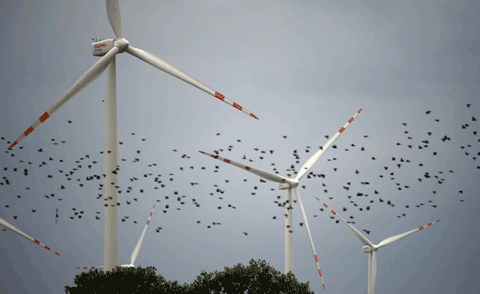Save Birds by Promoting Wind Energy
9 May, 2009 10:53 am
A new study shows that wind farms and nuclear power plants are substantially better for avian wildlife than fossil-fueled power stations.
 |
Birds, for instance, can directly crash into a turbine blade when they are fixated on perching or hunting and pass through its rotor plane; they can strike its support structure; they can hit part of its tower; or they can collide with its associated transmission and distribution lines.
We are told that these risks are exacerbated when turbines are placed on ridges and upwind slopes, built close to migration routes, or operated during periods of poor visibility such as fog, rain, and at night. Some species, such as bats, face additional risks from the rapid reduction in air pressure near turbine blades, which can cause internal hemorrhaging through a process known as barotraumas. Indirectly, wind farms can positively and negatively physically alter natural habitats, the quantity and quality of prey, and the availability of nesting sites.
Yet the deluge of studies making such claims, while useful and important, nonetheless suffers from three common problems. Studies rarely compare their results with studies of other wind farms to contextualize their estimates, instead relying on a narrow sample size. Most do not compare the possible avian deaths from wind electricity with other sources, and when they do, studies typically do not compare them to other energy sources. None have so far attempted to calculate the number of avian deaths per kWh from energy sources so that more meaningful comparisons might be made between different forms of electricity supply.
In an attempt to address some of these shortcomings, one new albeit preliminary study conducted by this author has compared the avian deaths per GWh from three electricity systems: wind farms, fossil-fueled power plants (coal, natural gas, and oil generators), and nuclear power plants.
Avian wildlife can perish not only by striking wind turbines in the ways described above, but by smashing into nuclear power plant cooling structures, transmission and distribution lines, and smokestacks at fossil-fuel fired power stations. Birds can starve to death in forests ravaged by acid rain, ingest hazardous and fatal doses of mercury, drink contaminated water at uranium mines and mills, or die in large numbers as climate change wreaks havoc on migration routes and degrades habitats.
For wind turbines, the risk appears to be greatest to birds striking towers or turbine blades and for bats suffering barotrauma. For fossil-fueled power stations, the most significant fatalities come from climate change, which is altering weather patterns and destroying habitats that birds depend on. For nuclear power plants, the risk is almost equally spread across hazardous pollution at uranium mine sites and collisions with draft cooling structures.
When these avian deaths are correlated with the units of electricity those power plants produce, some may find the results surprising. Based on real world operating experience of 339 wind turbines comprising six wind farms constituting 274 MW of installed capacity in the U.S., average avian mortality for wind appears to be about 0.269 fatalities per GWh.
Based on real world operating experience for two coal facilities as well as the indirect damages from mountain top removal coal mining in Appalachia, acid rain pollution on wood thrushes, mercury pollution, and anticipated impacts of climate change, average avian mortality for fossil fueled power stations appears to be about 5.18 fatalities per GWh.
Based on real world operating experience at four nuclear power plants and two uranium mines and mills, average avian mortality for nuclear systems is about 0.416 GWh.
In terms of birds killed per electricity produced, nuclear power is slightly worse but comparable to wind energy, but fossil-fueled facilities are about 17 times more dangerous to birds on a per kWh basis. In absolute terms, since wind turbines produced a relatively small amount of national electricity in the United States in 2006, they may have killed about 7,000 but fossil fueled stations killed 14.5 million and nuclear power plants 327,000.
Clearly, wind energy is not as bad for birds as many environmentalists make it out to be, and conventional resources are much more damaging to birds than is commonly believed.
Of course, a few caveats must be stated. Far more detailed, rigorous, and sophisticated analysis is called for that takes into account the complexities of the wind, fossil-fueled, and nuclear energy fuel cycles, and the sample size for many parts of this study is small.
Yet perhaps wind turbines seem to present a significant threat to birds because all of their environmental impacts are concentrated in one place, while those from conventional and nuclear fuel cycles are spread across space and time. Avian mortality and wind energy has consequently received far more attention and research than the avian deaths associated with coal, oil, natural gas, and nuclear power generators, even though this study suggests that wind energy may be the least harmful to birds.
For further reading
Benjamin K. Sovacool, “Contextualizing Avian Mortality: A Preliminary Appraisal of Bird and Bat Fatalities from Wind, Fossil-Fuel, and Nuclear Electricity,” Energy Policy 37(6) (June, 2009), pp. 2241-2248, available at http://www.spp.nus.edu.sg/Faculty_Benjamin_K_Sovacool.aspx.
-
12/12/12
“Peak Oil” is Nonsense… Because There’s Enough Gas to Last 250 Years.
-
05/09/12
Threat of Population Surge to "10 Billion" Espoused in London Theatre.
-
05/09/12
Current Commentary: Energy from Nuclear Fusion – Realities, Prospects and Fantasies?
-
04/05/12
The Oil Industry's Deceitful Promise of American Energy Independence
-
14/02/12
Shaky Foundations for Offshore Wind Farms







 Read more
Read more
http://www.wisecountyissues.com/?p=138
Furthermore, comparison with other sources is irrelevant unless building wind facilities will reduce those sources to a degree that will also reduce the harm. Thus the only comparison worth making would be with other sources of energy (not, e.g., house cats, cars, or skyscrapers). Sovacol assumes that connecting more wind reduces the use of other sources of energy, but that has yet to be proven, even in European countries that have substantial wind energy. He also appears to count transmission lines as belonging to "other sources", as if wind-generated electricity does not also require the same grid.
The conclusion is therefore that wind adds to the toll -- needlessly, since other sources have not been shown to be reduced by adding wind to the grid.
I thought I?d briefly weigh in on two points. First, Rucio?s point that wind energy doesn?t displace fossil fuel or nuclear energy strikes me as odd. The more electricity that wind turbines generate, the less electricity that is needed from conventional sources. This is not mere conjecture. To take a paragraph from another one of my articles, this one in Utility Policy:
Renewable power generators already displace a significant share of baseload generation, contrary to the beliefs of many within the American electricity industry. The U.S. EIA has determined that ?the imposition of a national renewable portfolio standard (a law mandating the use of renewable generators) would lead to lower generation from natural gas and coal facilities.? Examinations of fuel generation in several states confirm this finding. The New York State Energy and Research Development Authority looked at load profiles for 2001 and concluded that 65 percent of the energy displaced by wind turbines in New York would have otherwise come from natural gas facilities, 15 percent from coal-fired plants, 10 percent from oil-based generation, and 10 percent from out of state imports of electricity. Alden Hathaway, Director of Green Power Programs at the Environmental Resources Trust, found that every new kWh of renewable generation in Virginia would displace a portfolio of coal, natural gas, and oil facilities. In Texas, the Union of Concerned Scientists noted that renewable energy technologies primarily displace natural gas and coal facilities.
This article is still in press but can be accessed at linkinghub.elsevier.com/retrieve/pii/S0957178708000611 for those with access to the journal.
Second, Kansas Man raises an excellent point about how different birds will be sensitive to different types of land impacts. Although wind turbines leave much of the land they ?use? available for other uses, they can fragment habitat when sited poorly or in densely forested areas. I?m not sure this means that the estimates are comparable across energy sources?wind and nuclear don?t contribute to acid rain and have much smaller lifecycle emissions of greenhouse gases, making them advantageous for many types of birds. But more detailed study is certainly called for. As I conclude in my study about avian mortality (the actual article, not the post on Scitizen):
The shortcomings of this preliminary study are as obvious as they are numerous: a focus on bird deaths but not bird births; a small sample size for wind, coal, and nuclear facilities that may not be representative; a focus on individual species such as the wood thrush or waterfowl to produce overall estimates of avian mortality that are definitely not representative (and undoubtedly conservative); a presumption that coal was only mined using mountaintop removal (thereby excluding the impacts from other types of coal mining); fatalities that happened on particular days and weeks that were then presumed to be the only ones throughout the year (also resulting in conservative estimates); an assumption that only carbon dioxide emissions from power plants contribute to climate change (again conservative for excluding other greenhouse gases); highly uncertain deaths attributed to climate change that may be prevented if future greenhouse gas emissions are significantly reduced.
Note that many of these factors could mean the negative impacts to birds from fossil fuels could be underestimated.
World energy needs are growing thus even if you increase the total contribution to our energy needs from wind from 1% to 5% in 5 years it does not mean that now (after the 5 years) you are using less energy from fossil fuels and nuclear sources. What it does mean is that less fossil fuels and nuclear energy are needed than would have been needed if wind energy had not increased production. You are decreasing the amount that fossil fuels and nuclear would have needed to increase. Because of growing demand, more fossil fuels and nuclear are likely to be used even if wind energy production increases. That is why even countries in Europe where wind has grown more quickly that in the US, still need more fossil fuels than they did 10 years ago.
However if we can get the rate of displacement to be higher than the rate of consumption growth, then wind will represent a growing percentage of our energy pie pie. If this can be kept up, eventually fossil fuel and nuclear energy consumption will fall below current levels.
Rucio is right that even more important than minimizing the negative impact of our energy sources is to reduce our energy consumption. However, Rucio we must do both. Dr. Sovacool's excellent article is addressing the production side. It is unfair to claim his article is lacking because it does not deal with another subject which is related but separate.
Also to tmullins. Yes people are by far #1 (though not the only consideration). It has already been established that wind is good for people so that is a non-issue (cleans our air, provides jobs, increases national security by making us less reliant on imported oil, reduces health costs and human misery associated with fossil fuel extraction, etc.). The question was if we do this that is good for people will it be devastating for birds and bats? If there is this trade-off, then we have to make a very tough choice, does the benefit to people outweigh the damage to the ecosystem? Dr. Sovacool is stating that this might not be a dilemma at all (though more study is needed), wind is good for people and our flying friends. Best analysis available so far suggests that wind energy is more likely to be a win-win.